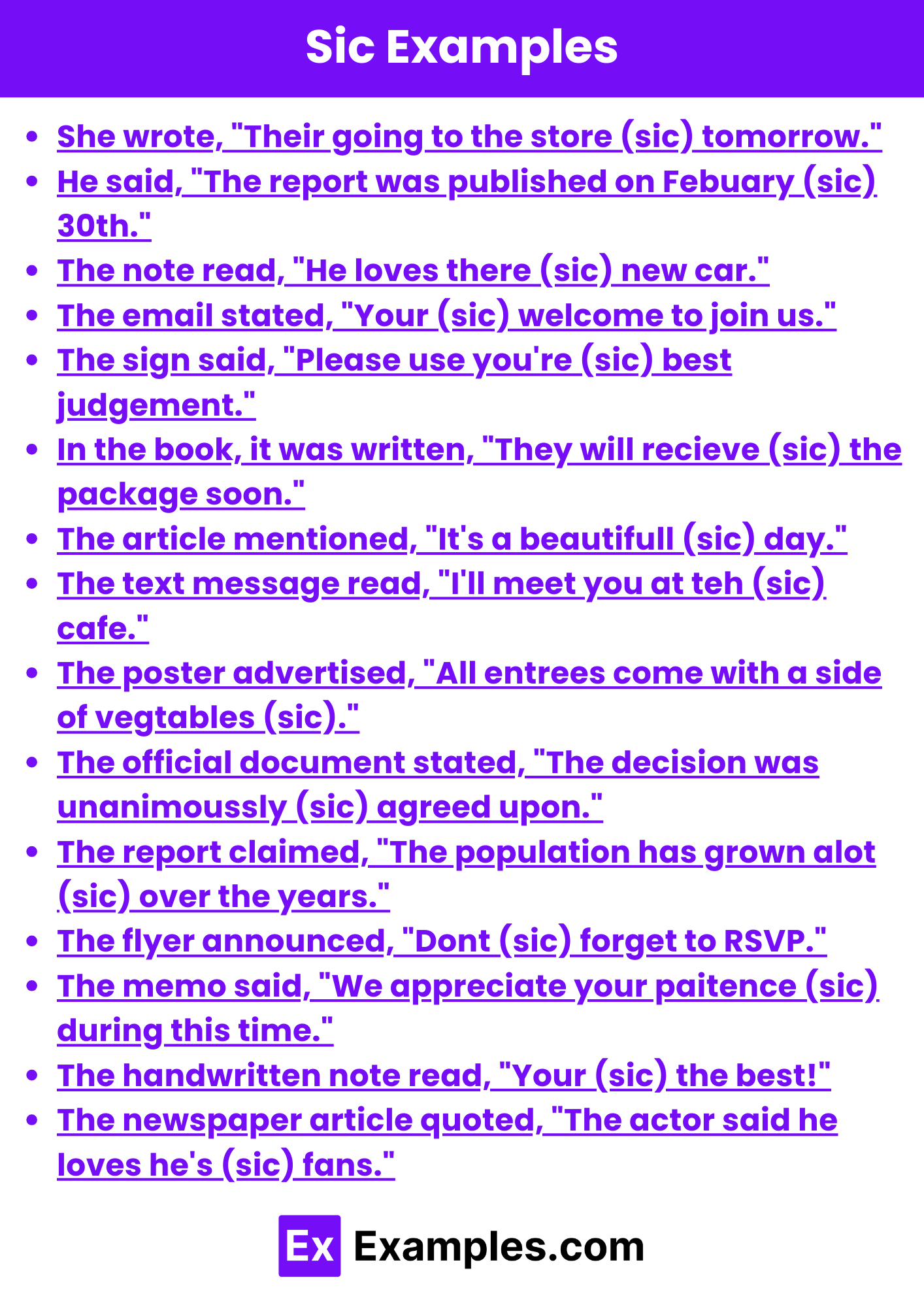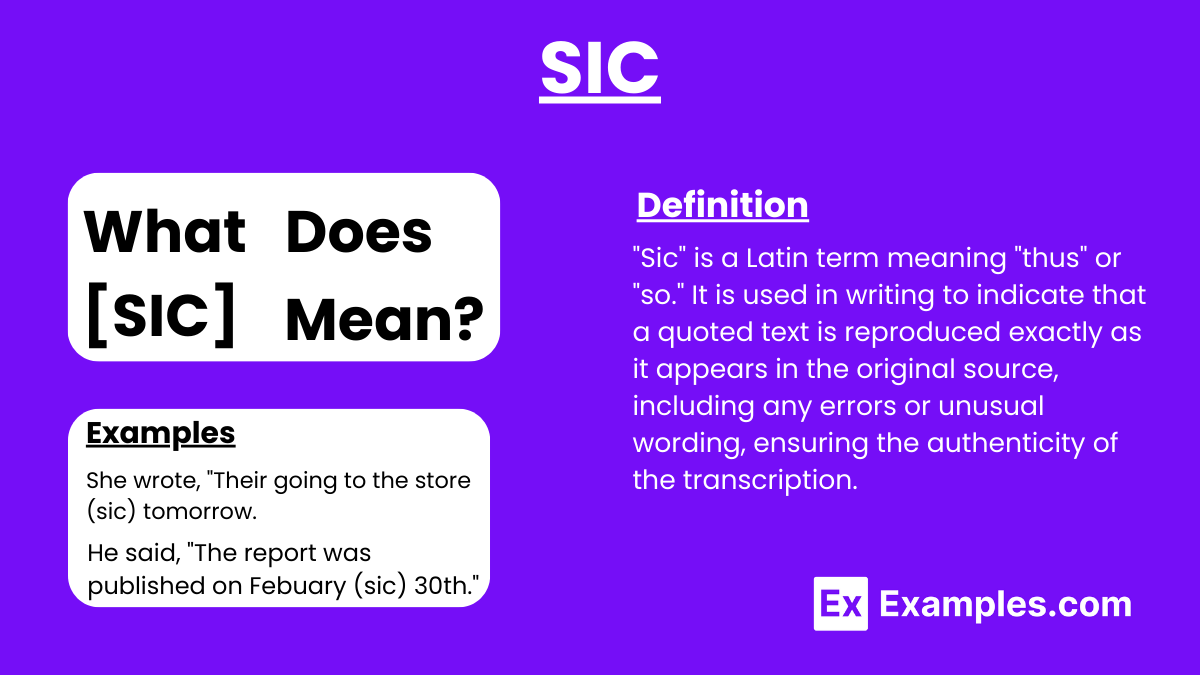16+ SIC Examples
“Sic” is a Latin term meaning “thus” or “so,” used in writing to indicate that a quoted text is transcribed exactly as it appears in the original source, including any errors or unusual phrasing. This ensures the reader understands that any mistakes or oddities are part of the original text, not the transcriber’s error. For example, in a historical document, a quote might read, “The event took place in 1895 (sic),” even if the correct date is 1896.
What is Sic?
“Sic” is a Latin term meaning “thus” or “so.” It is used in writing to indicate that quoted text is reproduced exactly as found in the original source, including any errors or unusual wording, to highlight authenticity.
Sic Examples

- She wrote, “Their going to the store (sic) tomorrow.”
- He said, “The report was published on Febuary (sic) 30th.”
- The note read, “He loves there (sic) new car.”
- The email stated, “Your (sic) welcome to join us.”
- The sign said, “Please use you’re (sic) best judgement.”
- In the book, it was written, “They will recieve (sic) the package soon.”
- The article mentioned, “It’s a beautifull (sic) day.”
- The text message read, “I’ll meet you at teh (sic) cafe.”
- The poster advertised, “All entrees come with a side of vegtables (sic).”
- The official document stated, “The decision was unanimoussly (sic) agreed upon.”
- The report claimed, “The population has grown alot (sic) over the years.”
- The flyer announced, “Dont (sic) forget to RSVP.”
- The memo said, “We appreciate your paitence (sic) during this time.”
- The handwritten note read, “Your (sic) the best!”
- The sign posted, “Please do not leav (sic) trash.”
- The email included, “She is their (sic) favorite teacher.”
- The newspaper article quoted, “The actor said he loves he’s (sic) fans.”
- The message stated, “Its (sic) important to follow the rules.”
Different Ways [Sic] Can Be Written
- In Brackets – Use [sic] immediately after the error in the quoted text.
- In Italics – Write sic in italics to distinguish it from the original text.
- With Quotation Marks – Enclose “sic” in quotation marks to indicate it is a direct notation.
- After Error – Place sic directly after the word or phrase containing the error.
- With Explanation – Use [sic: error] to specify the type of mistake.
- In Footnotes – Include sic in a footnote to provide additional context for the error.
What Does [Sic] Indicate?
- Clarifies Errors – Indicates that errors in the quoted text are part of the original.
- Maintains Authenticity – Ensures the quoted material is reproduced exactly as found.
- Prevents Confusion – Helps readers understand that the error is not the transcriber’s mistake.
- Highlights Original Text – Draws attention to unusual wording or errors in the source.
- Provides Transparency – Shows that the text is being presented as it originally appeared.
- Supports Accuracy – Confirms the authenticity and accuracy of the quoted material.
Workaround for Using [Sic]
- Paraphrase the Quote – Reword the text to convey the same meaning without quoting the error directly.
- Use Ellipses – Replace the error with an ellipsis to indicate omitted content.
- Use a Note or Footnote – Provide a note or footnote explaining the original error.
- Insert a Correction – Correct the error within the quote using brackets, e.g., “Their [they’re] going to the store.”
- Provide a Contextual Explanation – Explain the error in the main text rather than within the quote itself.
- Highlight the Error – Use italics or bold to draw attention to the error instead of using [sic].
Where [Sic] Usually Appears
- In Academic Papers – To indicate original errors in quoted research or historical documents.
- In News Articles – To show that quoted errors come from the original source.
- In Legal Documents – To maintain the integrity of verbatim quotes with errors.
- In Social Media Posts – To highlight mistakes in quoted tweets or comments.
- In Books – To preserve the authenticity of direct quotes containing errors.
- In Emails – To clarify that errors in forwarded messages were in the original.
- In Essays – To point out mistakes in quoted materials for analysis.
- In Transcripts – To indicate that spoken errors are faithfully recorded.
How to Identify if your child is using the [Sic] slang word
- Listen to Conversations – Pay attention to your child’s use of the word “sic” or “sick” in their speech.
- Check Text Messages – Review your child’s text messages for the slang usage of “sic” or “sick.”
- Understand Context – Note if “sic” or “sick” is used to describe something impressive or cool.
- Observe Social Media – Monitor your child’s social media posts and comments for this slang.
- Ask Directly – Have a conversation with your child about their use of slang words like “sic” or “sick.”
How to talk with your child about use of the [Sic] slang word
- Initiate the Conversation – Start with a casual, non-judgmental question about their language use.
- Show Understanding – Acknowledge that slang is a part of youth culture and that you’re curious.
- Ask for Meaning – Request your child to explain what “sic” means to them and how they use it.
- Discuss Appropriateness – Talk about when and where slang is appropriate versus more formal settings.
- Share Your Perspective – Explain your concerns or reasons for discussing their language use, emphasizing mutual respect.
- Set Guidelines – Agree on acceptable use of slang at home, school, and other environments.
- Stay Open-Minded – Be willing to learn from your child and keep the dialogue ongoing.
- Encourage Clear Communication – Highlight the importance of clear and respectful communication in different contexts.
SIC Similar and opposite words
Similar Words for Sic
- Thus
- So
- As such
- Like that
- Accordingly
- In that manner
- In this way
- Exactly
- Precisely
- Verbatim
Opposite Words for Sic
- Incorrectly
- Improperly
- Mistakenly
- Erroneously
- Inaccurately
- Falsely
- Wrongly
- Incompletely
- Unfaithfully
- Distortedly
When is “sic” used?
“Sic” is used to indicate that quoted text is exactly as found in the original source.
How is “sic” punctuated?
“Sic” is typically enclosed in brackets: [sic].
Can “sic” be used in formal writing?
Yes, “sic” is often used in formal writing to maintain accuracy in quotations.
Should “sic” be italicized?
No, “sic” is usually not italicized unless it matches the formatting style.
Is there a space before “sic”?
Yes, there is a space before the brackets [sic].
Can “sic” indicate intentional errors?
Yes, “sic” indicates that the error is present in the original text.
Where should “sic” be placed in a sentence?
“Sic” is placed immediately after the error in the quoted text.
Is “sic” used in everyday conversation?
No, “sic” is primarily used in written text, not in everyday conversation.
Can “sic” be used in legal documents?
Yes, “sic” is commonly used in legal documents to indicate exact quotes.
Is “sic” the same as “i.e.”?
No, “sic” indicates exactness in quoting errors, while “i.e.” clarifies information.



